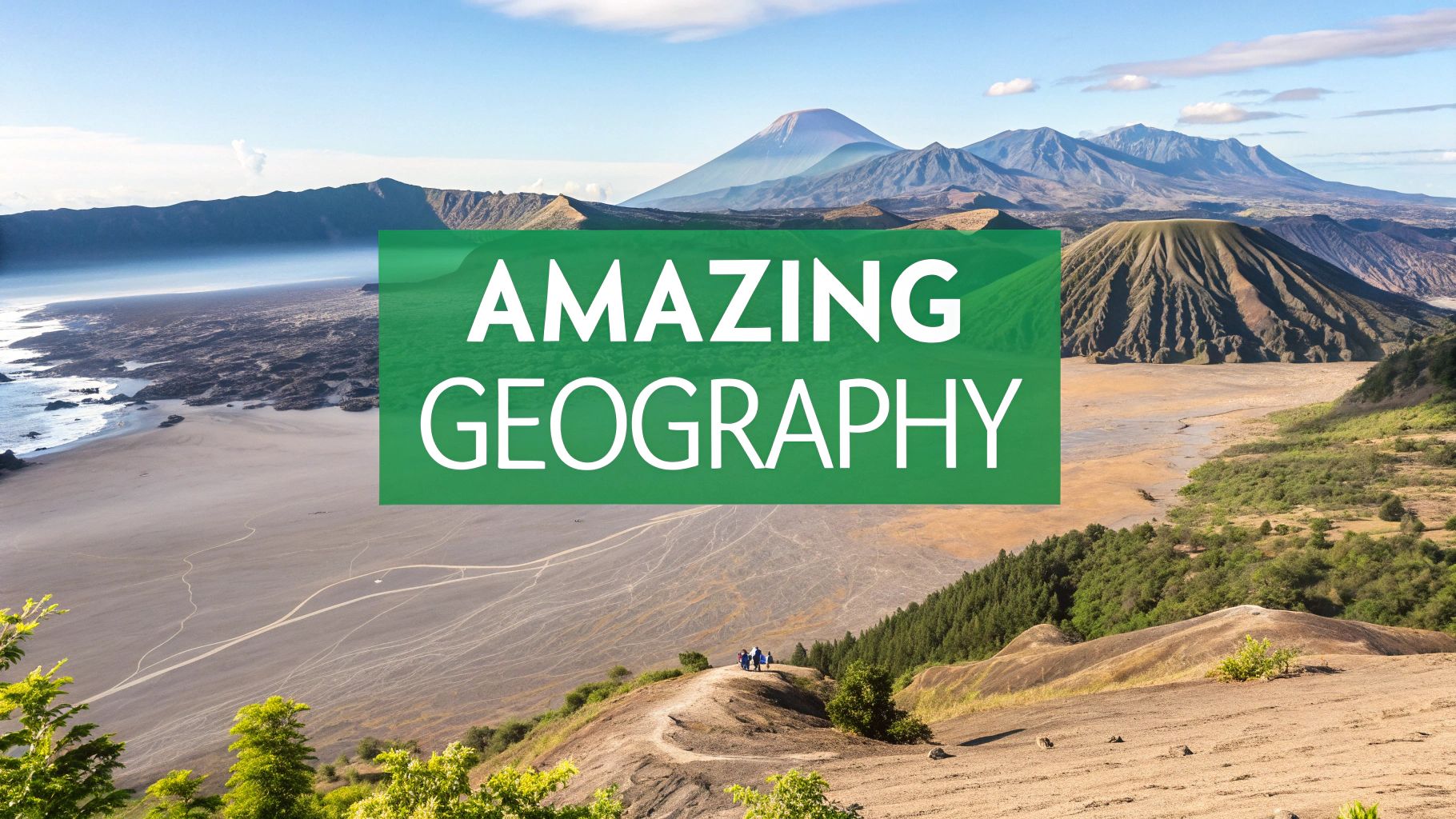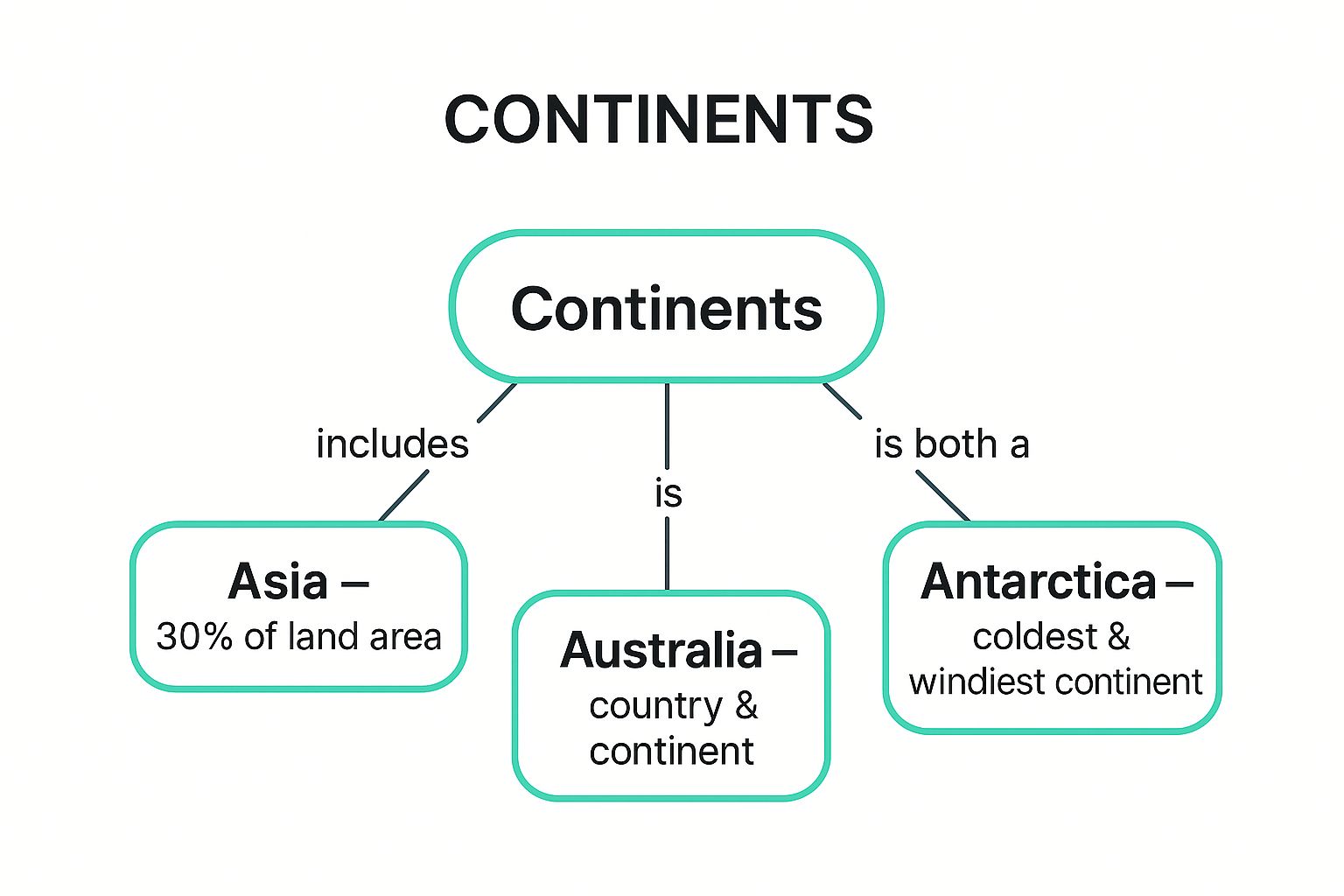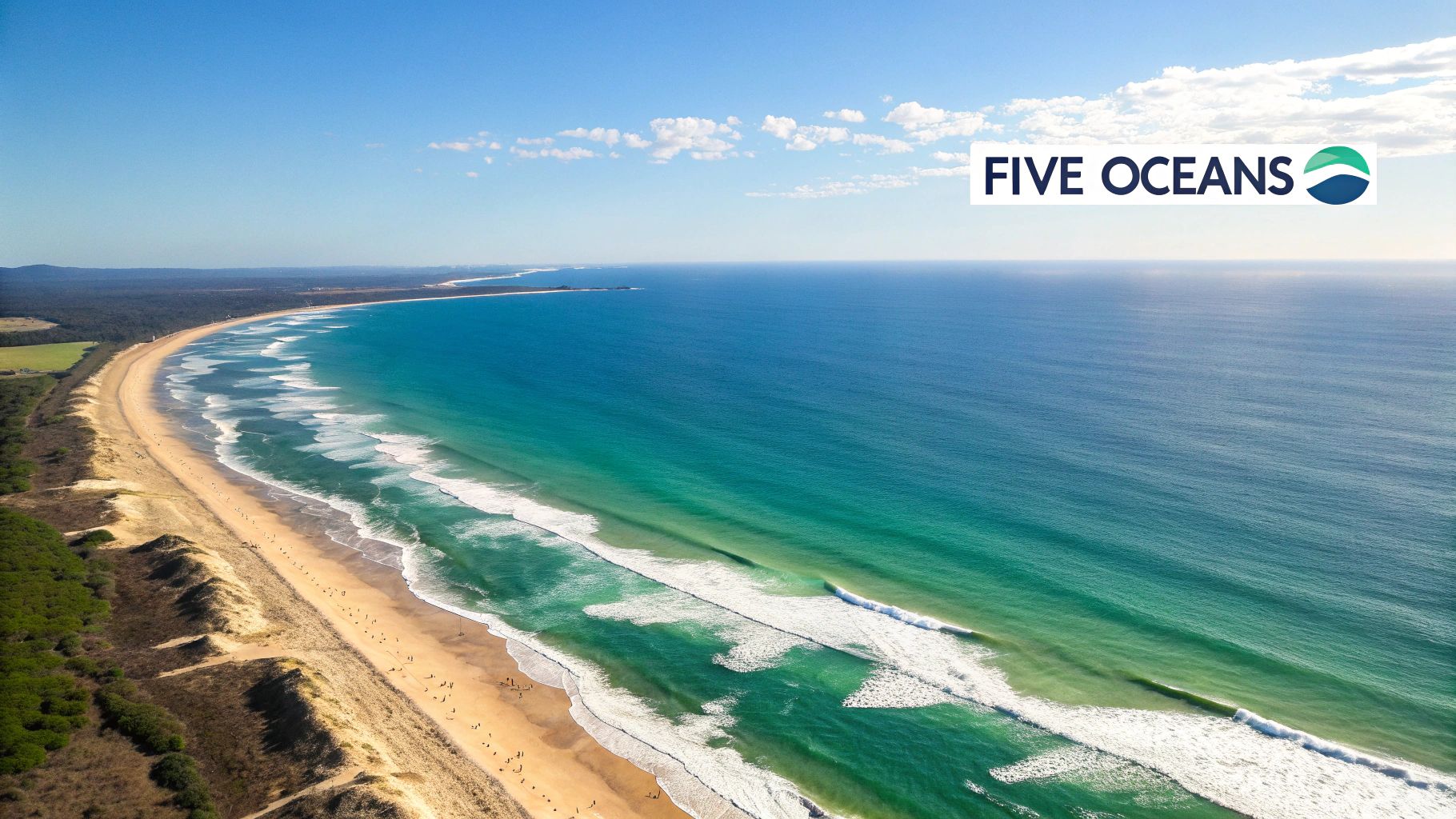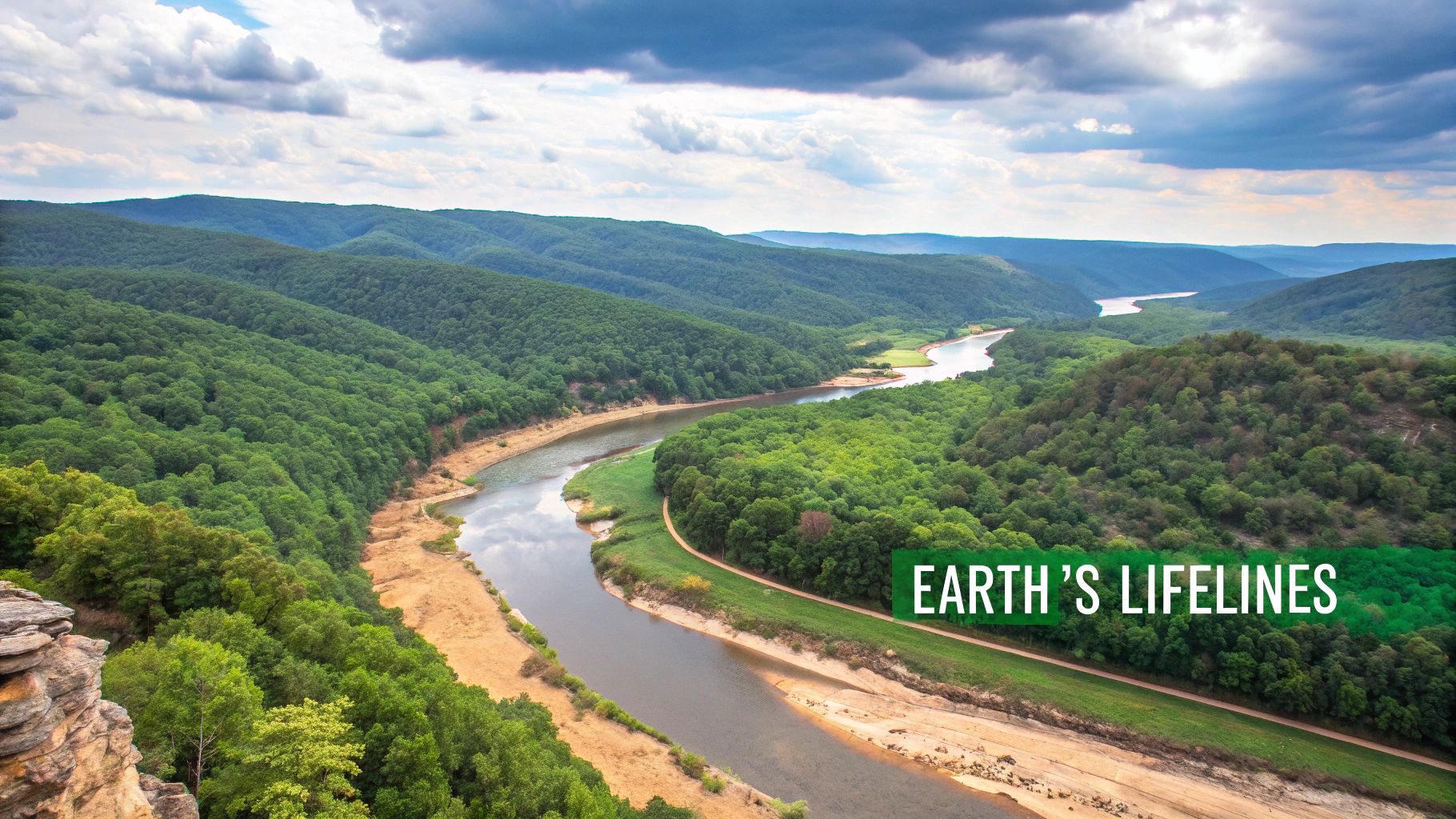8 Amazing Geography Facts for Kids in 2025
Discover 8 incredible geography facts for kids! Learn about continents, oceans, volcanoes, and more in this fun, educational guide for young explorers.

Welcome, future world explorers! Have you ever wondered why our planet is so amazing? From fiery mountains that build new islands to icy poles where the sun disappears for months, Earth is full of incredible secrets. We're about to embark on a journey to uncover some of the most mind-blowing geography facts for kids. Think of our world as a giant, interactive puzzle, and this guide is your key to unlocking its greatest mysteries.
Each fact is a clue to understanding our world a little better. You'll learn things that will wow your friends, family, and even your teachers. To make it even more fun, we'll show you how you can experience these wonders yourself in the exciting 3D world of EarthChasers. This isn't just a list; it's a launchpad for your next big adventure. Get your explorer's hat on because it's time to discover the magic of geography
1. Earth's Seven Continents Are Like Giant Puzzle Pieces
Did you know the ground beneath your feet is always moving? Earth’s land is divided into seven massive areas called continents: Asia, Africa, North America, South America, Antarctica, Europe, and Australia/Oceania. This is one of the most foundational geography facts for kids to learn.
These continents weren't always separated. About 200 million years ago, they were joined together in a single supercontinent called Pangaea. Over time, due to a process called plate tectonics, they drifted apart. This movement is incredibly slow, about the same speed your fingernails grow!
How It Works
This constant, slow movement has shaped our planet. For example, the Atlantic Ocean widens by about two inches every year as North and South America move away from Europe and Africa. In another part of the world, the mighty Himalaya Mountains are still growing because the landmass of India is pushing into Asia. Scientists can even see how the coast of South America fits neatly against Africa’s coast, just like puzzle pieces.
The infographic below highlights some unique facts about a few of the continents.

The visualization shows how diverse the continents are, from Asia's massive size to Australia's unique status as both a country and a continent.
Quick Tips for Learning the Continents
- Remember by Size: A great way to memorize them is by size, from largest to smallest: Asia, Africa, North America, South America, Antarctica, Europe, and Australia.
- Use a Mnemonic: Try this silly sentence: "All Ants Need Small Ant Eating Apples" to remember the first letter of each continent.
Ready to explore them all? Learn more about the seven continents on earthchasers.com to continue your adventure.
2. The Earth Has Five Amazing Oceans
Did you know that most of our planet is covered in water? Oceans cover about 71% of Earth's surface and hold nearly 97% of all the water we have. It’s one of the most important geography facts for kids to understand. We have five massive oceans: the Pacific, Atlantic, Indian, Southern (also called the Antarctic), and Arctic.

These giant bodies of saltwater are all connected, forming one huge global ocean that surrounds the continents. The Pacific Ocean alone is so enormous that it’s larger than all of Earth's land combined! These oceans are home to incredible marine life and have a huge impact on our weather and climate.
How It Works
Oceans are constantly in motion, with currents acting like giant rivers that move warm and cold water around the globe. For example, the Gulf Stream in the Atlantic Ocean brings warm water north, which helps keep places like Europe warmer than they would be otherwise. Oceans are also incredibly deep; the Mariana Trench in the Pacific is so deep that Mount Everest could fit inside it with room to spare. Unfortunately, our oceans also show the impact of human activity, like the Great Pacific Garbage Patch, a large area of floating trash.
Quick Tips for Learning the Oceans
- Remember by Size: A great way to memorize them is by size, from largest to smallest: Pacific, Atlantic, Indian, Southern, and Arctic.
- Use a Mnemonic: The first letters spell out PAISA, which can be an easy way to recall their order.
- Think Pacific = Peaceful: The name Pacific means "peaceful," but just remember it's the biggest and mightiest of them all
3. Rivers Are Earth's Lifelines and Highways
Did you know that rivers are like the planet's circulatory system? They are flowing bodies of freshwater that usually start from sources like springs or melting snow and travel downhill until they reach a larger body of water, like a sea or an ocean. This is one of the most dynamic geography facts for kids to understand, as rivers constantly shape the world around us.
They are essential for life, providing water for drinking, farming, and creating habitats for countless animals. For thousands of years, people have also used rivers as highways for travel and trade, building great civilizations along their banks. The longest river in the world is the Nile in Africa, stretching an incredible 4,135 miles.

How It Works
Rivers have immense power to change landscapes. The fast-moving water of the Colorado River, for example, carved the massive Grand Canyon over millions of years. In South America, the Amazon River is so enormous that it carries more water than any other river on Earth and is home to unique creatures like pink river dolphins.
Closer to home, the Mississippi River system in the United States is a vital transportation route that drains water from 31 different states. Rivers demonstrate how water moves across the land, carrying soil and nutrients that create fertile areas like deltas where they meet the sea.
Quick Tips for Learning About Rivers
- Flow Direction: Always remember that rivers flow downhill from a source to a sea or ocean, not the other way around.
- Map It Out: Find a local river on a map and trace its path. See if you can discover its source and where it eventually ends up.
- Observe in Person: If you can, safely visit a nearby river or stream. Look at how the water moves and notice how it has shaped the banks and the land around it.
4. Mountains Reach for the Sky in Amazing Ways
Did you know that mountains are more than just big hills? They are giant landforms that rise dramatically above the ground around them. Some of the most interesting geography facts for kids are about how these massive structures are formed by incredible forces like crashing continents, fiery volcanoes, or the slow wearing away of land by wind and water.
The tallest mountain on Earth, Mount Everest, stands an incredible 29,032 feet high in the Himalaya range. Mountains are so big they can create their own weather. They also act as the planet's water towers, storing fresh water in snow and glaciers that melt and feed rivers. This creates unique environments for special plants and animals that have adapted to life at high altitudes.
How It Works
Mountains are born in a few different ways. Fold mountains, like the Himalayas, are created when two of Earth's tectonic plates collide and push the land upward. Volcanic mountains, such as Japan's famous Mount Fuji, are built up layer by layer from hardened lava and ash. The Andes in South America form the longest mountain range in the world, stretching over 4,300 miles.
This process of mountain building is often incredibly slow but powerful. It shapes everything from global climate patterns to where people decide to live.
Quick Tips for Learning About Mountains
- Spot them on Maps: Look for triangle symbols or shaded relief on maps to identify mountain ranges. This is a great way to see where the highest points are.
- Trace the Rivers: Notice how many major rivers begin in mountainous areas. This is because they are often fed by melting snow and ice from the peaks.
- Remember the Rule: The higher you go up a mountain, the colder the air gets. This is why the tallest peaks are often covered in snow year-round.
Curious about how high your local hills or a famous peak are? Find out their exact height with our handy elevation finder tool on earthchasers.com and see the world from a new perspective.
5. Deserts Are Surprisingly Diverse and Amazing
What do you picture when you think of a desert? Most likely, it's a hot, sandy place with camels, like the Sahara. But the most important geography fact for kids about deserts is that they are defined by a lack of rain, not heat. Any region that gets less than 10 inches of precipitation per year is a desert.
Because of this, deserts can be surprisingly different from one another. The Sahara in Africa is the world's largest hot desert, bigger than the entire United States. But did you know Antarctica is the largest desert of all? Its icy landscape gets very little snowfall, making it a polar desert. This variety makes deserts some of the most fascinating biomes to study.
How It Works
Deserts exist all over the world and can be hot, cold, coastal, or even semi-arid. Despite the tough conditions, life finds a way. Plants like cacti have waxy skin to hold in water, while animals like the fennec fox have large ears to release body heat and stay cool. The Atacama Desert in Chile is the driest non-polar place on Earth; some parts have not seen rain in centuries. Meanwhile, the Arabian Desert has the largest continuous area of sand in the world, called the Rub' al Khali or "Empty Quarter."
Quick Tips for Learning About Deserts
- Remember the Rule: The key is a lack of water, not high temperatures. This is why cold places like Antarctica count!
- Look for Adaptations: When you see a desert plant or animal, try to spot its survival tricks. Does it have deep roots to find water or light-colored fur to reflect the sun?
- Explore on a Map: Use a world map to find the major deserts like the Sahara, Gobi, Atacama, and Arabian. See how different their locations and surrounding climates are.
Ready to see these incredible landscapes? Begin your journey through the world's diverse biomes at earthchasers.com and discover them for yourself.
6. The Equator Is Earth's Invisible Hot Belt
Did you know there's an imaginary belt wrapped around the middle of our planet? This line is called the equator, and it sits at 0° latitude, exactly halfway between the North and South Poles. Learning about this feature is one of the most interesting geography facts for kids because it explains so much about our world’s climate.
Countries located along the equator receive the most direct sunlight all year long. This consistent, intense sunlight is why these regions are typically hot and humid. The equator passes through 13 countries, including Ecuador, which even got its name from the Spanish word for "equator." These areas experience unique conditions, like tropical rainforests and days that are almost always 12 hours long.
How It Works
Because the sun's rays hit the equator at a direct angle, the energy is concentrated, leading to higher temperatures. This consistent heat and light create the perfect environment for lush, dense jungles like the Amazon rainforest. In cities like Quito, Ecuador, the high altitude combines with the equatorial location to create a spring-like climate year-round. Singapore, another bustling city, is located just 85 miles north of this invisible line.
Quick Tips for Understanding the Equator
- Find It on a Map: Look for the line labeled 0° latitude on a globe or world map. Notice how many of the green, forested areas of the planet are clustered around it.
- Remember the Name: Think of the word equator like the word equal. It divides the Earth into two equal halves (the Northern and Southern Hemispheres) and often has nearly equal hours of day and night.
7. The North and South Poles Are Earth's Extreme Ends
Did you know Earth has two extreme points at its very top and bottom? These are the North and South Poles, where the planet's axis of rotation meets its surface. These polar regions are some of the coldest places on Earth and experience unique phenomena like months of continuous daylight, called the "midnight sun," and months of complete darkness, known as the "polar night."
The North Pole is located in the middle of the Arctic Ocean and is covered by a massive sheet of floating sea ice. The South Pole, on the other hand, sits on the continent of Antarctica, which is buried under thousands of feet of solid ice. This makes them fascinating geography facts for kids to explore.
How It Works
These frozen worlds are opposites in many ways. For instance, the Arctic (North Pole) is an ocean surrounded by land, while Antarctica (South Pole) is a continent surrounded by an ocean. This difference creates unique ecosystems. Polar bears roam the floating ice of the north, while penguins waddle across the icy land of the south. Another amazing feature near the North Pole is the dazzling light show in the sky called the Northern Lights or Aurora Borealis.
Quick Tips for Learning About the Poles
- Remember the Animals: A simple way to keep them straight is: Arctic has Bears, and Antarctica has penguins. You will never find them living together in the wild!
- Land vs. Ice: Think "North Pole = No land" because it's just floating ice. Remember "South Pole = Solid land" because it's a continent.
- Earth's Freezers: The polar regions act like giant freezers for our planet, storing about 70% of the world's fresh water as ice.
While the poles don't have capital cities, you can discover the cities closest to these extreme regions and every other country by checking out a map of world capitals on earthchasers.com.
8. Volcanoes Are Earth's Spectacular Fire Mountains
Have you ever wondered how mountains can breathe fire? Volcanoes are openings in Earth's crust where super-hot melted rock called magma, along with gas and ash, escape from deep underground. Once this magma reaches the surface, it’s called lava. This is one of the most explosive geography facts for kids you'll ever learn.
There are about 1,500 potentially active volcanoes on our planet. They are powerful enough to create new islands, like the Hawaiian Islands, which were all formed by volcanic activity. Most volcanoes are found along the edges of tectonic plates in an area around the Pacific Ocean known as the "Ring of Fire."
How It Works
Volcanoes can be incredibly destructive but also creative forces of nature. The 1980 eruption of Mount St. Helens in Washington was so powerful it blew over 1,300 feet off the top of the mountain. In ancient times, the eruption of Mount Vesuvius in 79 AD famously buried the entire Roman city of Pompeii in ash, preserving it for centuries. Today, Kilauea in Hawaii has been erupting almost continuously since 1983, constantly reshaping the island.
Quick Tips for Volcano Spotting
- Learn the Lingo: Remember the three main types: active (currently erupting or has recently), dormant (sleeping but could erupt again), and extinct (unlikely to ever erupt again).
- Trace the Ring of Fire: On a map, look for the horseshoe-shaped line of volcanoes that circles the Pacific Ocean. It’s where most of Earth’s eruptions happen!
- Visit Safely: You can see the effects of volcanic activity at places like Yellowstone National Park, with its geysers and hot springs all powered by underground magma.
Geography Facts Overview: 8 Key Topics Compared
| Item | Implementation Complexity 🔄 | Resource Requirements ⚡ | Expected Outcomes 📊 | Ideal Use Cases 💡 | Key Advantages ⭐ |
|---|---|---|---|---|---|
| Earth's Seven Continents | Low - conceptual understanding and mapping | Minimal - maps and infographics | Basic geographic knowledge and historic insight | Education, geography learning, puzzle analogy | Clear visualization of Earth's land division |
| The Earth Has Five Amazing Oceans | Moderate - studying vast marine systems | High - oceanographic tools and expeditions | Understanding climate, marine ecosystems | Marine science, environmental studies | Insight into climate regulation and biodiversity |
| Rivers Are Earth's Lifelines | Moderate - field studies and hydrological data | Medium - mapping, water quality/testing | Water resource management and ecological health | Agriculture, urban planning, ecology | Critical for civilization and freshwater supply |
| Mountains Reach for the Sky | High - requires geological surveys and climbing | High - specialized equipment and expertise | Knowledge of elevation, weather influence | Climatology, conservation, adventure tourism | Freshwater source and unique biodiversity |
| Deserts Are Surprisingly Diverse | Low to Moderate - ecological and climatic analysis | Low to medium - field observations | Awareness of desert adaptations and climates | Ecology, renewable energy (solar), mineral extraction | Diverse ecosystems and resource potential |
| The Equator Is Earth's Invisible Hot Belt | Low - conceptual and map-based study | Minimal - maps and climatological data | Understanding climate zones and biodiversity | Climate education, global geography | Explains tropical climate and day-night equality |
| The North and South Poles | High - extreme conditions and specialized research | Very High - polar expeditions and technology | Climate records and weather pattern insights | Climate science, polar research | Crucial for Earth’s climate regulation |
| Volcanoes Are Earth's Spectacular Fire Mountains | High - geological study and monitoring | High - monitoring equipment and safety gear | Hazard prediction, geothermal energy insights | Disaster management, energy, tourism | Creates fertile land and new geological features |
Keep Exploring and Become an EarthChaser!
You've just journeyed across the globe from the comfort of your screen, uncovering some of the most amazing geography facts for kids! From the drifting continents that fit together like massive puzzle pieces to the fiery power of volcanoes shaping our planet, you now hold the keys to understanding the world in a whole new way. We've seen how rivers act as lifelines for entire civilizations and how deserts, far from being empty, are vibrant and diverse ecosystems.
These facts are more than just trivia; they are the building blocks for seeing the connections that tie our world together. Understanding the Equator helps explain why some places are tropical paradises, while knowing about the Poles reveals the incredible resilience of life in extreme cold. Each fact, from the deepest ocean trench to the highest mountain peak, adds another layer to the incredible story of Planet Earth.
Your Adventure Is Just Beginning
The best way to make these lessons stick is to keep your curiosity alive. Don't let this be the end of your exploration. The next time you see a mountain, think about the tectonic forces that pushed it skyward. When you look at a world map, trace the paths of ancient rivers and imagine the journeys people took along them. Turning knowledge into a real adventure is the ultimate goal.
Here are a few ways to keep the momentum going:
- Challenge a Friend: See who can name all seven continents and five oceans the fastest.
- Map Your World: Grab a globe or an online map and find the major landmarks we discussed, like the Amazon River, the Sahara Desert, and Mount Everest.
- Become a Digital Explorer: Use your new knowledge to level up your gameplay and see these concepts in action.
The world is a vast and exciting place, filled with endless wonders waiting to be discovered. By learning these fundamental geography facts for kids, you've built a strong foundation to become a true global explorer. Keep asking questions, keep searching for answers, and you'll be amazed at what you find.
Ready to turn your geography knowledge into an epic quest? Dive into the world of EarthChasers, where you can race across continents, explore virtual volcanoes, and uncover ancient secrets. Start your adventure and become a master explorer today at EarthChasers
